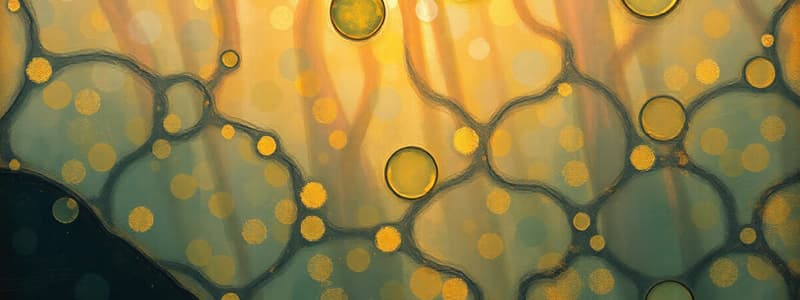Podcast
Questions and Answers
What is the primary mechanism driving the UNIDIRECTIONAL TRANSPORT of substances across a cellular sheet in Victorian Transport?
What is the primary mechanism driving the UNIDIRECTIONAL TRANSPORT of substances across a cellular sheet in Victorian Transport?
- Simple diffusion across the cellular membrane
- Active transport on one side and diffusion on the opposite side (correct)
- Osmosis through the cell membrane
- Facilitated diffusion on both sides of the cell
What role do the Solute Carrier (SLC) transporters play in the process of absorption across the epithelium?
What role do the Solute Carrier (SLC) transporters play in the process of absorption across the epithelium?
- Secondary active transport for entry of substances into the cell (correct)
- Efflux transport to remove substances from the cell
- Facilitated diffusion at both sides of the cell
- Simple diffusion assisting with passive transport
How does temperature affect the absorption process across the epithelium?
How does temperature affect the absorption process across the epithelium?
- It has no significant effect on absorption rates.
- Higher temperatures increase the rate of diffusion. (correct)
- Temperature only affects facilitated diffusion and not active transport.
- Higher temperatures decrease the rate of diffusion.
Which of the following correctly describes a factor that influences absorption across the epithelium?
Which of the following correctly describes a factor that influences absorption across the epithelium?
What distinguishes ATP-binding cassette (ABC) transporters from Solute Carrier (SLC) transporters?
What distinguishes ATP-binding cassette (ABC) transporters from Solute Carrier (SLC) transporters?
What effect does emphysema have on oxygen diffusion in the lungs?
What effect does emphysema have on oxygen diffusion in the lungs?
How does pneumonia impact the diffusion distance for oxygen absorption?
How does pneumonia impact the diffusion distance for oxygen absorption?
What is the role of P-glycoprotein in drug absorption?
What is the role of P-glycoprotein in drug absorption?
What factor influences the absorption speed of a drug based on its molecular properties?
What factor influences the absorption speed of a drug based on its molecular properties?
How does stomach acidity affect the absorption of acid-labile drugs?
How does stomach acidity affect the absorption of acid-labile drugs?
Flashcards
Victorian Transport
Victorian Transport
Transport across an entire epithelial sheet, involving movement through both cell membranes and the intracellular space.
Solute carrier (SLC) superfamily
Solute carrier (SLC) superfamily
A superfamily of membrane proteins that facilitate the entry of substances into cells via secondary active transport or facilitated diffusion.
ATP-binding cassette (ABC) superfamily
ATP-binding cassette (ABC) superfamily
A superfamily of membrane proteins that actively pump substances out of cells, requiring energy from ATP.
Transcellular transport
Transcellular transport
Signup and view all the flashcards
Factors influencing absorption
Factors influencing absorption
Signup and view all the flashcards
Surface Area for Diffusion
Surface Area for Diffusion
Signup and view all the flashcards
Diffusion Distance
Diffusion Distance
Signup and view all the flashcards
Size and Molecular Weight
Size and Molecular Weight
Signup and view all the flashcards
Drug Ionization
Drug Ionization
Signup and view all the flashcards
Efflux Transporters
Efflux Transporters
Signup and view all the flashcards
Study Notes
Absorption Across the Epithelium
- Victorian transport describes substance movement across entire epithelial sheets, not just cell membranes.
- This occurs in various tissues including intestines, renal tubules, exocrine glands, gallbladder, choroid plexus, and placenta.
- Transport involves active transport across one side of a cell, followed by either simple or facilitated diffusion across the opposite side.
- This unidirectional transport is achieved by different transporter families on opposite cell faces.
- Solute carriers (SLCs) facilitate influx in secondary active or facilitated transport.
- ATP-binding cassette (ABC) transporters facilitate efflux in active transport.
- Examples include absorption from the intestine to blood, from blood to bile, across kidney tubules, and from blood to other body cells.
Factors Influencing Absorption
-
Physiological factors influence absorption rate:
- Temperature: higher temperatures increase diffusion rates.
- Surface area: larger surface areas allow faster absorption.
- Diffusion distance: shorter distances facilitate quicker absorption.
-
Pharmacological considerations:
- Stomach acidity affects acid-labile drugs, potentially impacting absorption. This may necessitate enteric-coated tablets.
- Gastrointestinal motility affects drug absorption. Drugs might be taken on an empty stomach to optimize absorption.
- Presence of efflux transporters, such as P-glycoprotein, can reduce drug absorption. Dosage adjustments might be needed with concurrent inhibitors of P-glycoprotein.
-
Factors related to the substance itself:
- Size and molecular weight: smaller substances absorb more quickly.
- Ionization: non-ionized (lipophilic) drugs absorb more easily across cell membranes than ionized (hydrophilic) drugs. Ionization depends on the drug's pKa and the surrounding pH.
-
Drug interactions: Cardiac glycosides like digoxin can have interactions with other drugs impacting P-glycoprotein-mediated transport, affecting absorption and elimination.
-
Examples include macrolide antibiotics (e.g., erythromycin) and anti-epileptic drugs (e.g., carbamazepine), which can affect Digoxin absorption in terms of increasing absorption or eliminating it in urine.
Applications of Victorian Transport Info
- Ezetimibe inhibits cholesterol transport.
- Gliflozins block glucose reabsorption in the kidneys, lowering blood sugar levels.
Studying That Suits You
Use AI to generate personalized quizzes and flashcards to suit your learning preferences.
Related Documents
Description
This quiz covers the mechanisms of absorption across epithelial tissues, focusing on Victorian transport. Explore key concepts such as active transport, facilitated diffusion, and the role of various transporter families. Test your knowledge on how physiological factors like temperature affect absorption rates.




